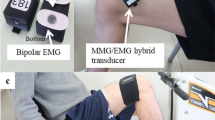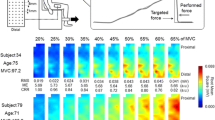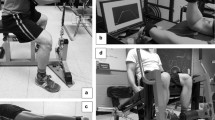Abstract
The objectives of this study were (i) to determine the reproducibility of computer measurements of isometric strength and related electromyography in several muscle groups in sedentary middle-aged women, (ii) to evaluate the effects of different digital signal averaging methods on the reproducibility, (iii) to determine the final test score to be preferred in terms of improved reproducibility of isometric strength measurements, and (iv) to evaluate potential advantages provided by the computer measurement. Fifteen subjects were measured three times within a 2-week period. The measurements consisted of recordings of maximal isometric strength and rate of force production during trunk extension and flexion, leg extension and dominant forearm flexion with simultaneous recordings of surface electromyography, except in the trunk flexors. The following four final test scores were determined for each trial: the maximum of the three scores, the mean of the two highest scores, the median of the three scores and the mean of the three scores. The scores for the strength measurement were generally more reproducible (coefficient of variation, CV, approximately 6% and intraclass correlation coefficient ICCC, approximately 0.90) than those of the other measurements (CV > 10%, ICCC 0.13–0.97). There was no obvious preference for any type of final test score or for the width of the averaging window in the computer analysis. For isometric strength the reproducibility of the computer measurements was comparable to that of the voltmeter assessments. Computer analysis seems to be a versatile method for determining parameters of neuromuscular performance with reasonable reproducibility.
Similar content being viewed by others
References
Bauer DC, Browner WS, Cauley JA, Orwoll ES, Scott JC, Black DM, Tao JL, Cummings SR (1993) Factors associated with appendicular bone mass in older women. Ann Intern Med 118:657–665
Baumgartner TA (1989) Norm-referenced measurement: reliability. In: Safrit MJ, Wood TM (eds) Measurement concepts in physical education and exercise science. Human Kinetics Books, Champaign, Ill., pp 62–65
Challis RE, Kitney RI (1982) The design of digital filters for biomedical signal processing. 1. Basic concepts: the design of digital filters for biomedical signal processing. J Biomed Eng 4:267–278
Daanen HAM, Mazure M, Holewijn M, Van der Velde EA (1990) Reproducibility of the mean power frequency of the surface electromyogram. Eur J Appl Physiol 61:274–277
DeVries HA (1968) Efficiency of electrical activity as a physiological measure of the functional state of muscle tissue. Am J Phys Med 47:10–22
Gollhofer A, Horstmann GA, Schmidtbleicher D, Schönthal D (1990) Reproducibility of electromyographic patterns in stretch-shortening type contractions. Eur J Appl Physiol 60:7–14
Komi PV, Bushkirk ER (1970) Reproducibility of electromyographic measurements with inserted wire electrodes and surface electrodes. Electromyography 4:357–367
Patterson RP, Baxter T (1988) A multiple muscle strength testing protocol. Arch Phys Med Rehabil 69:366–368
Sale DG (1987) Influence of exercise and training on motor unit activation. Exerc Sport Sci Rev 15:95–151
Simoons ML, Hugenholtz PG, Ascoop CA, Distelbrink CA, DeLand PA, Vinke RVM (1981) Quantitation of exercise electrocardiography. Circulation 63:471–475
Sinaki M, Offord KP (1988) Effect on back muscle strength and bone mineral density of the spine. Arch Phys Med Rehabil 69:277–280
Sinaki M, McPhee MC, Hodgson SF, Merritt JM, Offord KP (1986) Relationship between bone mineral density of spine and strength of back extensor in healthy postmenopausal women. Mayo Clin Proc 61:116–122
Veiersted KB (1991) The reproducibility of test contractions for calibration of electromyographic measurements. Eur J Appl Physiol 62:91–98
Viitasalo JT, Saukkonen S, Komi PV (1980) Reproducibility of measurements of selected neuromuscular performance variables in man. Electromyogr Clin Neurophysiol 20:487–501
Viitasalo JT, Era P, Leskinen AL, Heikkinen E (1985) Muscular strength profiles and anthropometry in random samples of men aged 31–35, 51–55 and 71–75 years. Ergonomics 28:1563–1574
Viljanen, T, Viitasalo JT, Kujala U (1989) Isometric trunk extension and flexion strength of Finnish urban women and men aged 25–55 years. In: Telama R, Laakso L, Pieron M, Ruoppila I, Vihko V (eds) Physical education and life-long physical activity. Gummeruksen Kirjapaino, Jyväskylä, pp 550–559
Viljanen T, Viitasalo JT, Kujala UM (1991) Strength characteristics of a healthy urban adult population. Eur J Appl Physiol 63:43–47
Yang JF, Winter DA (1983) Electromyography reliability in maximal and submaximal isometric contractions. Arch Phys Med Rehabil 64:417–420
Zeh J, Hansson T, Bigos S, Spengler D, Battie M, Wortley M (1986) Isometric strength testing: recommendations based on a statistical analysis of the procedure. Spine 11:43–46
Author information
Authors and Affiliations
Rights and permissions
About this article
Cite this article
Heinonen, A., Sievänen, H., Viitasalo, J. et al. Reproducibility of computer measurement of maximal isometric strength and electromyography in sedentary middle-aged women. Europ. J. Appl. Physiol. 68, 310–314 (1994). https://doi.org/10.1007/BF00571449
Accepted:
Issue Date:
DOI: https://doi.org/10.1007/BF00571449




